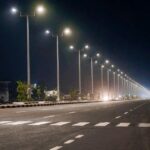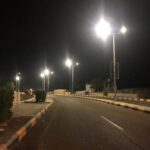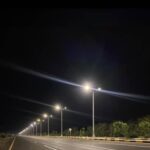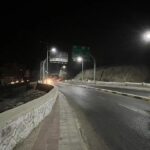What is a solar street light controller, and why does it matter? In the realm of solar-powered street lighting, the controller plays a pivotal role in ensuring optimal performance and efficiency. Today, we intend to dive into the significance of a solar street light controller by unveiling its’ features that define its functionality. As we unravel these essential components, you’ll gain a deeper understanding of how a well-designed controller contributes to the reliability and effectiveness of our solar street lighting systems.

Functionality of Solar Street Light Controllers
Primarily, these controllers function as intelligent regulators, overseeing the seamless interaction between solar panels, batteries, and LED lights. Photovoltaic cells within the solar panels convert incident solar radiation into electrical energy, initiating the charging phase. The solar street light controller, equipped with advanced algorithms, monitors the voltage and current generated by the solar panels. During the charging process, the controller ensures that the battery receives the optimal amount of energy without overcharging, a critical aspect in extending battery lifespan.
As daylight wanes, and the need for illumination arises, the controller seamlessly transitions to the discharging phase. It acts as the gatekeeper, permitting the release of stored energy from the battery to power the LED lights. This transition is managed with meticulous precision to avoid over-discharging, a phenomenon that could compromise battery health.
Moreover, solar street light controllers employ sophisticated circuitry and microprocessors to modulate the flow of energy. By maintaining a delicate equilibrium between the energy input from the solar panels and the energy output to the LED lights, these controllers maximize energy utilization and minimize wastage.
The Key Features of a solar street light controller
A solar street light controller exhibits a myriad of key features, each integral to its function in optimizing the performance of solar-powered lighting systems. What are these features?
- Maximum Power Point Tracking (MPPT): The controller actively employs MPPT technology, dynamically adjusting the electrical operating point of the solar panels to extract the maximum available power from incident sunlight. This ensures optimal energy conversion efficiency, particularly in variable environmental conditions.
- Pulse Width Modulation (PWM) Control: A critical feature involves the application of PWM control, where the controller modulates the width of the charging pulses to regulate the energy flow to the battery. This precision-controlled modulation prevents overcharging and safeguards the battery from potential damage, thereby extending its operational life.
- Voltage Regulation: Scientifically calibrated voltage regulation mechanisms are in place to maintain the battery voltage within the designated safe operating range. This proactive regulation mitigates the risk of overvoltage, safeguarding the integrity of both the battery and connected components.
- Temperature Compensation: The controller incorporates temperature sensing and compensation mechanisms, actively adjusting charging parameters based on the ambient temperature. This dynamic compensation ensures optimal charging efficiency across a spectrum of environmental conditions, enhancing overall system reliability.
- Load Control: An active load control feature enables the precise management of energy distribution from the battery to the LED lights. The controller intelligently regulates the discharge process, preventing over-discharge and ensuring a steady, sustained power supply to the lighting system.
- Data Logging and Monitoring: Utilizing advanced microprocessors, the controller facilitates data logging and real-time monitoring of key performance metrics. This data-driven approach allows for comprehensive system analysis, enabling timely diagnostics and adjustments for enhanced operational efficiency.
- Dusk-to-Dawn Operation: The controller incorporates light-sensing capabilities to enable automatic dusk-to-dawn operation. By actively monitoring ambient light levels, it triggers the illumination system when darkness descends and conserves energy during daylight hours.
- Reverse Current Protection: Robust reverse current protection mechanisms are integrated to prevent the flow of energy from the battery back into the solar panels during periods of low or no sunlight. This safeguards the solar panels and maintains the integrity of the entire solar power system.
Solar street lights controller
The Benefits of a street light controller
Why is a controller important in your solar street light setup?
Energy harvesting optimization
The controller employs advanced algorithms to dynamically adjust the charging parameters based on real-time solar irradiance and ambient conditions. By actively monitoring and responding to fluctuations in environmental variables, it fine-tunes the operation of the solar street light system, enabling it to harness the maximum available solar energy at any given moment.
Battery Management for Prolonged Lifespan
The battery management system employs Coulomb counting techniques and impedance spectroscopy to assess the state of charge and internal resistance of the battery. This data is then utilized to adapt the charging profile, preventing the battery from operating in conditions that could compromise its chemical integrity. The controller also integrates a temperature control mechanism that actively adjusts the charging rate based on the ambient temperature. This is crucial in preventing thermal stress, a phenomenon that can adversely affect the electrochemical processes within the battery cells, ultimately leading to premature aging.
Additionally, the solar street light controller incorporates a feature known as equalization charging, a method that balances the individual cells within the battery pack. This process, based on the principles of electrochemistry, ensures uniform charge distribution among cells, mitigating capacity imbalances and further promoting longevity.
Intelligent Power Distribution
The solar street light controller serves as the central nervous system of the solar-powered lighting system, employing advanced algorithms and sensors to dynamically manage and allocate electrical power. This entails real-time monitoring of environmental conditions such as solar irradiance, ambient light levels, and battery status. Through a judicious application of scientific principles, the controller orchestrates the efficient distribution of power to the various components of the solar street light system.
During periods of optimal sunlight exposure, the solar street light controller intelligently directs surplus energy to charge the high-capacity batteries. Scientifically calibrated charging algorithms ensure the batteries are charged to their optimal levels, maximizing their lifespan and overall performance.
Furthermore, the solar street light controller employs scientific principles of adaptive control to regulate the brightness of the LED lights based on prevailing environmental conditions. Photometric sensors integrated into the controller assess ambient light levels, allowing for automatic adjustment of illumination intensity. This not only enhances energy efficiency but also contributes to the overall sustainability of the solar street lighting system
Fault Detection and Diagnostics
The implementation of Fault Detection and Diagnostics (FDD) in a solar street light controller represents a pivotal advancement in ensuring the robustness and reliability of solar-powered lighting systems.
One key advantage of incorporating FDD into a solar street light controller lies in its ability to detect faults at an early stage, enabling swift intervention and mitigation. Scientifically, FDD utilizes sensor data to analyze parameters such as voltage levels, current flow, temperature, and other critical electrical variables. This method ensures a comprehensive assessment of the system’s health, allowing for the identification of anomalies that may lead to malfunctions or reduced efficiency.
Moreover, FDD facilitates a precise diagnosis of the detected faults, employing advanced analytical tools and algorithms rooted in scientific principles. By pinpointing the root cause of a malfunction, the solar street light controller can expedite the troubleshooting process, minimizing downtime and optimizing energy utilization.
Remote monitoring and control
Remote monitoring involves the continuous surveillance of key parameters, such as solar panel output, battery charge status, and overall system health, utilizing advanced telemetry systems. Scientifically calibrated sensors collect data, which is then transmitted to a central control hub for analysis. This data-driven approach enables operators to make informed decisions based on precise scientific metrics, ensuring the solar street light system operates within its optimal parameters.
The precision of remote monitoring extends to the implementation of control mechanisms that allow you to dynamically influence the system’s behavior. You can remotely adjust lighting intensity, optimize energy consumption, and even schedule maintenance activities. This level of control is underpinned by a scientific understanding of the interplay between various factors.
Innovations in a solar street light controller
As technology continues to advance, what are the areas where improvements are being made in solar street light controllers?
- IoT Integration: Improved controllers often include Internet of Things (IoT) capabilities, allowing for remote monitoring, control, and management of each street light. This helps in real-time status monitoring and fault detection.
- Wireless Connectivity: Controllers are incorporating advanced wireless communication technologies for seamless connectivity, enabling centralized monitoring and control.
- Adaptive Lighting Control: Controllers can adjust the brightness of street lights based on real-time conditions such as traffic density, pedestrian activity, and ambient light levels.
- Mobile Apps and Web Interfaces: Controllers are incorporating user-friendly interfaces, often accessible through mobile apps or web portals, making it easier for administrators to monitor and control the street lights.
- Motion Sensors: Integration of motion sensors enables the lights to brighten when motion is detected and dim when the area is unoccupied, saving energy.
- Hybrid Systems: Controllers are being designed to integrate seamlessly with other renewable energy sources like wind or grid power, providing a more reliable energy supply.
solar street lights controller
Conclusion
It’s evident that these innovative devices are not just components of a sustainable future but catalysts for transformative change in urban and rural landscapes alike. Beyond the technical intricacies lies a promise of efficiency, resilience, and a brighter tomorrow. Embracing solar street light controllers isn’t merely an act of adopting advanced technology; it’s a commitment to forging a more sustainable and luminous path forward. Do you need a solar street light with an advanced controller? Contact us.


















